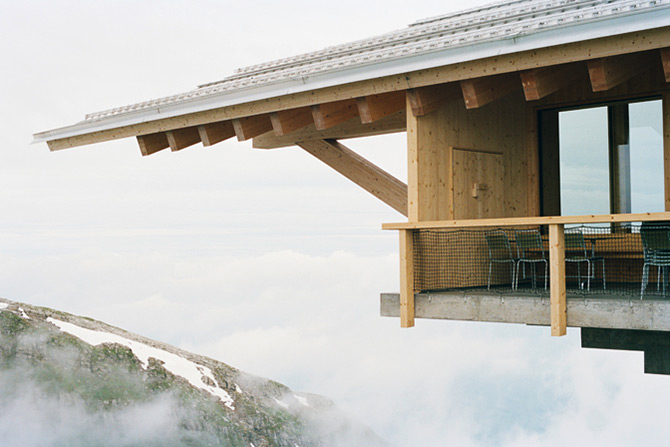Ever since the cable car to the Chäserrugg went into operation in 1972, the restaurant on top of the mountain, 7.420 feet above sea level, had been provisionally located in the housing originally built for the construction workers. Now it has been torn down to make room for a new restaurant designed by Herzog & de Meuron. The station, a pragmatic steel structure on a concrete foundation typical of the 1970s, has been left untouched and been clad in a different façade. The new mountain restaurantis placed perpendicular to the station, extending horizontally along the mountain panorama towards the south. A large roofed area connects the two structures and creates an outdoor arrival hall.
“We used wood in order to develop a language and materiality that suits the Toggenburg region, but without resorting to the usual Alpine clichés,” says Christine Binswanger, Senior Partner in charge. ”The project was executed by craftspeople from the valley. Because local companies were involved, those working on the project were committed heart and soul. It was possible to make sustainable use of resources.”
Description of the project by Herzog & de Meuron
As the easternmost of the seven peaks of the Churfirsten Massif, the Chäserrugg rises 2262 meters above the sea. To the north, from the Toggenburg, the crest rises gently up and rushes southward as a steep rock wall almost 1,900 m down to Walensee. The Hinterrugg, Rosenboden and Chäserrugg peaks form a plateau, whose horizontality is in stark contrast to the rocky and steep walls around. Behind this impressive topography, the mountain scenery of the Alps extends to the horizon. This unique place is accessible since 1972, thanks to the cable car between Unterwasser, Iltios and Chäserrugg, whose valley station can be reached in less than an hour from Zurich and St. Gallen. Since completion of the cable car there was a temporary restaurant, which was originally built as accommodation for the workers. This has now been replaced by a new building. The building, typical of its age, is a steel construction on a concrete base, and will remain in use with a new facade. Perpendicular to it, extending along the mountain landscape, is the new mountain restaurant. As a unifying element, a large roof covers the two structures and creates an outdoor arrivals lounge.

Image of the new mountain-top restaurant and cable car station in Chäserrugg, Switzerland, by Herzog & de Meuron. Photography © Katalin Deér.
The new mountain station is a solid wood construction on a concrete base. It was manufactured by local craftsmen in the valley and constructed during the summer. During the following winter the interior work was completed. We chose wood because we wanted to record the local building tradition. It was also a matter of moderation with resources: except for the crane, which flew in by helicopter, all parts of the building have come up with the cable car. For the concrete works, the land resulting from the excavation was processed and reused as gravel.
The restaurant is a long, flexible space whose atmosphere is characterized by the repetitive structure of pine. The roof sustained by beams placed close together is the dominant element of the new building with an outdoor terrace under it. The interior of the restaurant is glass on three sides, offering spectacular views. The fourth side of the space is formed by niches with benches and tables. Each place has its own window, its own share of framed mountains.
CREDITS. DATA SHEET.-
Architects.- Jacques Herzog, Pierre de Meuron, Christine Binswanger (Partner in charge)
Projekt Team- Michael Fischer (Associate, Project Director), Beatus Kopp, Hendrik Steinigeweg (Project Managers), Salomé Gutscher (Project Architect), Roman Aebi (Workshop), Michael Bär (Associate), Frederik Bo Bojesen, Leif Buchmann, Yannick Claessens, Santiago Espitia-Berndt, Alexander Franz, Alen Guberinic, Justin Hui, Maria Krasteva, Victor Lefebvre (Workshop), Severin Odermatt, Philipp Schaefle, Kaspar Stöbe, Christoph Wassmann, Freya Winkelmann
Dates.- 27.09.2013 - 26.06.2015
Area of the plot.- 6700 m²
Area of the building.- 2500 m² (new construction) 1580 m² (existing building)
Construction manager .- Ghisleni.
HVACR.- Amstein + Walthert.
Structural framework.- Schnetzer Puskas Ingenieure, Pirmin Jung, Schällibaum.
Acoustic Consultant.- Bau und Raumakustik, Pirmin Jung.
Construction Consultant.- Zimmermann & Leuthe
Gastronomy Infrastructure Consultant.- Gastro-Fachplanungen Ruedi Menet.
Fire protection Consultant.- Amstein + Walthert.
Textile Consultant.- Rondelli Consulting
Snow load consultant.- WSL-Institut für Schnee - und Lawinenforschung SLF
Wind actions consultant.- I.F.I. Institut für Industrieaerodynamik GmbH






























